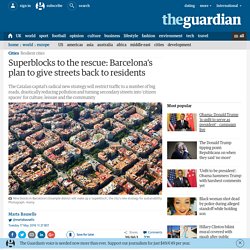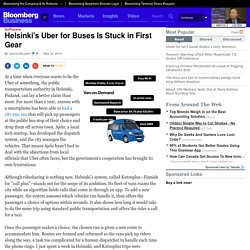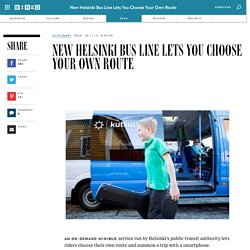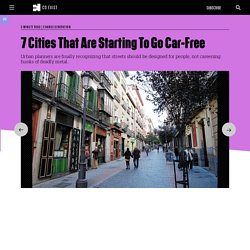

Superblocks to the rescue: Barcelona’s plan to give streets back to residents. In the latest attempt from a big city to move away from car hegemony, Barcelona has ambitious plans.

Currently faced with excessive pollution and noise levels, the city has come up with a new mobility plan to reduce traffic by 21%. And it comes with something extra: freeing up nearly 60% of streets currently used by cars to turn them into so-called “citizen spaces”. The plan is based around the idea of superilles (superblocks) – mini neighbourhoods around which traffic will flow, and in which spaces will be repurposed to “fill our city with life”, as its tagline says.
This plan will start in the famous gridded neighbourhood of Eixample. That revolutionary design, engineered by Ildefons Cerdà in the late 19th century, had at its core the idea that the city should breathe and – for both ideological and public health reasons – planned for the population to be spread out equally, as well as providing green spaces within each block. El primer bosque de comida está por abrir en Seattle. Traveling Salesman Problem. The Traveling Salesman Problem is one of the most intensively studied problems in computational mathematics.

These pages are devoted to the history, applications, and current research of this challenge of finding the shortest route visiting each member of a collection of locations and returning to your starting point. Hey Siri, how can I solve the TSP? YouTube, mov, or mp4 The work described here is supported by the Natural Sciences and Engineering Research Council of Canada (NSERC) and the Department of Combinatorics and Optimization at the University of Waterloo. Contact: William Cook (bico@uwaterloo.ca) Ley de Movilidad impulsa la regularización del transporte. Split - Share & Save. Helsinki's Uber for Buses Is Stuck in First Gear - Businessweek. At a time when everyone wants to be the Uber of something, the public transportation authority in Helsinki, Finland, can lay a better claim than most.

For more than a year, anyone with a smartphone has been able to hail a city-run van that will pick up passengers at the public bus stop of their choice and drop them off across town. Ajelo, a local tech startup, has developed the dispatch system, and the city manages the vehicles. That means Ajelo hasn’t had to deal with the objections from local officials that Uber often faces, but the government’s cooperation has brought its own frustrations. Although ridesharing is nothing new, Helsinki’s system, called Kutsuplus—Finnish for “call plus”—stands out for the scope of its ambition. Its fleet of vans roams the city while an algorithm fields calls that come in through an app.
Once the passenger makes a choice, the chosen van is given a new route to accommodate him. New Helsinki Bus Line Lets You Choose Your Own Route. An on-demand minibus service run by Helsinki’s public transit authority lets riders choose their own route and summon a trip with a smartphone.

Called Kutsuplus (Finnish for “call plus,” referring to the on-call nature of the service) the system of on-demand minibuses lets riders decide on a start and end point, and choose whether to share a journey or take a private trip. Called demand-responsive public transit, it’s designed for maximum flexibility. Riding Kutsuplus costs more than bus fare, but less than an expensive Helsinki taxi. At current exchange rates, it’s a $4.75 fee plus 60 cents per kilometer — less than half the cost of cab fare. Those costs vary based on how many people are riding. Carfree Cities. Fastcoexist. After over a hundred years of living with cars, some cities are slowly starting to realize that the automobile doesn't make a lot of sense in the urban context.

It isn't just the smog or the traffic deaths; in a city, cars aren't even a convenient way to get around. Traffic in London today moves slower than an average cyclist (or a horse-drawn carriage). Commuters in L.A. spend 90 hours a year stuck in traffic. A U.K. study found that drivers spend 106 days of their lives looking for parking spots. Now a growing number of cities are getting rid of cars in certain neighborhoods through fines, better design, new apps, and, in the case of Milan, even paying commuters to leave their car parked at home and take the train instead.
Unsurprisingly, the changes are happening fastest in European capitals that were designed hundreds or thousands of years before cars were ever built. Here are a handful of the leaders moving toward car-free neighborhoods. Madrid Paris. Asociación de Colonos ZEDEC Santa Fe AC – sociación de Colonos ZEDEC Santa Fe AC. No a 6 mil viviendas en el predio La Mexicana en Santa Fe, @GobCDMX @ManceraMiguelMX. Soy una vecina de Santa Fe que sufre todos los días de los graves problemas consecuencia de una mala planeación urbana de la zona.

Por esta razón a mí y a los vecinos nos preocupa que exista un proyecto para construir 6,000 viviendas en el terreno de la mina La Mexicana. Por eso pedimos al Gobierno de la Ciudad de México encabezado por Miguel Angel Mancera que no construya las viviendas, y que acepte el proyecto de parque en el 100% del terreno que proponen los vecinos de Santa Fe para la Mexicana. El Gobierno Federal expropió el terreno de la mina La Mexicana en 1984 para destinarlo a equipamiento urbano. Hasta el momento, no se ha hecho nada con el predio. Miguel Angel Mancera en su 3er informe de gobierno en septiembre pasado, declaró que al menos el 70% del terreno sería parque.